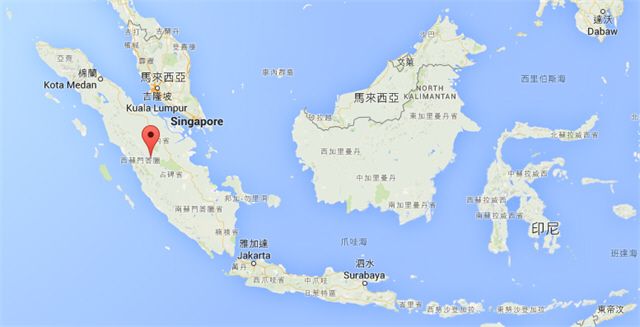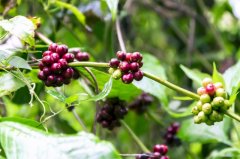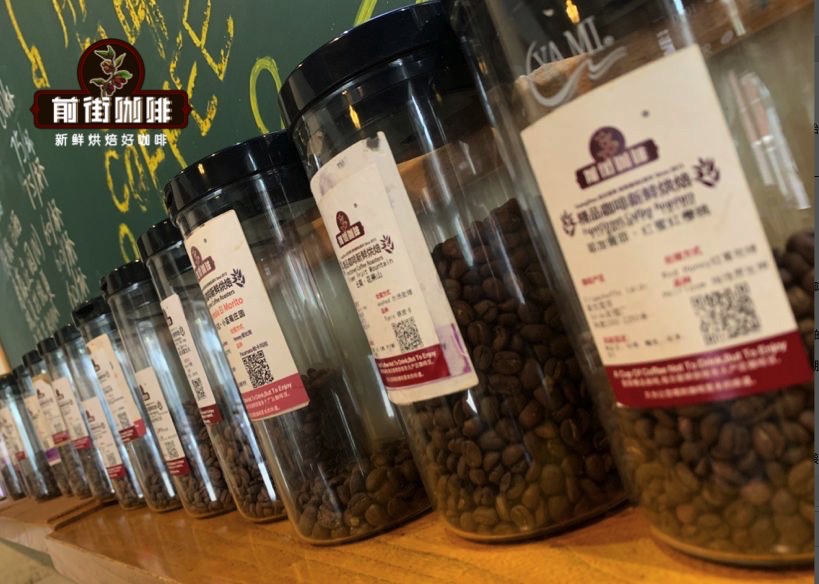Sumatran Coffee Bean birthplace Sumatran Geography classroom Custom, folklore, tourist attractions small Archives

For professional baristas, please follow the coffee workshop (Wechat official account cafe_style)
Sumatra coffee beans
Sumatra is one of the largest islands in Indonesia, and Sumatra coffee beans are characterized by low acidity and high concentration, grass-like aroma, and have a rich coffee taste. If you are a person who is afraid of drinking coffee acidity, choosing Sumatran coffee beans to taste is an opportunity you can't miss.
Mantenin coffee bean Pawani
Origin: Sumatra
Thick but not heavy taste and rich and rich flavor, reverberate with soft sour taste, no passion only lingering, is considered by many people to be one of the most romantic coffee in the world.
Pawani coffee beans are made with a rather unique semi-dry treatment. First, remove the outer skin of the coffee fruit, and remove the pulp inside, leaving the coffee seeds to dry with the outer coated gelatin, endocarp and Silverskin, then peeling off the dried colloid and endocarp, and finally screening and bagging.
Some people say that if there is a highway to Coffee Paradise, it should be paved with Pawani coffee beans.
Due to the drying process, coffee seeds contact with the pulp for a long time, so it can retain the natural flavor. It has aromas of fruit and malt; after brewing, it exudes aromas of flowers and spices, soil and chocolate; on the palate, you can taste round and rich flavors (or layers), a rich syrup-like taste, soft acidity, and almost no bitterness, with a long Aftertaste or Finish after drinking.
Sumatra
It belongs to an island in Indonesia. It can also be said to be a natural museum full of strong indigenous colors. The original boat-shaped longhouse is still preserved here, and the smell of cannibal tribes can still be smelled. There are so many races and complicated languages here that there are three capitals. It is Sumatra.
Brief introduction:
Indonesia is an archipelago country composed of more than 13.000 islands, with Kalimantan, Java and Sumatra in Borneo as the largest. Sumatra is the fifth largest island in the world and a narrow island running from northwest to southeast, giving birth to three capitals: Giant Harbor in the south, Padang in the middle and Medan in the north.
Sumatra and Malay Peninsula dominate the Strait of Malacca and control the traffic between India and Taiping, which is not only geographically important, but also greatly influenced by external influences since ancient times. It is also a concentration of overseas Chinese in Indonesia. Among the more than 30 million residents, apart from Chinese, Indians and Europeans, I can be roughly divided into 10 ethnic groups. The best known are Malay, West Malengen, Garo, Tuktuk, Tumok, Simanindo, Ambari, Batak Bataks (also known as Madas), Milan Pola, Milankabao, Aceh and Nias.
Among the Indonesian islands, Sumatra is an area rich in natural resources and cultural landscape. During the Dutch colonial period, oil, rubber, coffee and pepper were all supplied. It was also home to important oil fields in Indonesia, as well as natural gas fields, so it was called the black vault. On the narrow island of Sumatra, the Pegunungan Mountains stretch almost all over the island. There are about a hundred volcanoes in these mountains, of which more than 10 are still active. The eastern part is almost all lowland swamps, across the Strait of Malacca, facing the Malay Peninsula.
Customs and people's feelings:
There are too many indigenous people in Sumatra and the language is very complex, especially the capital Medan is the most complex area in Indonesia, where primitive Malays, Madas, Aceh, Meilanpola, Chinese, Indians and Europeans live here. Mount Mada lives with the Garo tribe, one of the six major tribes of Mada [Batak]. The motor people are Christian. They like to eat dog meat and pork (B1 for dog meat and B2 for pork) and live in an Ada rooftop tin house [in the early years, the roof was covered with palm leaves]. The women here have iron head skills, and like Indonesian women, they do not use their hands, but use their heads to top things. There is also a custom here that people are buried next to their homes after death without opening another graveyard.
The roofs of most Garo buildings are hung with sheep's heads (there are also on the roof of the airport). The sheep's head is a sign of the Garo people and can ward off evil spirits. Here, the number of buffalo heads is taken as the standard for getting a wife. Because in an agricultural country, people are generally required to make a living by farming {planting upland rice} and growing fruits, so each family has at least five children, and only 10 can be considered a large family. Walking on the road, you can see not only the woman with the top of her head, but also the bus painted red and green, with people or luggage piled up on the top of the bus.
Small file:
Population: more than 30 million.
Capital: giant harbor in the south; Padang in the middle; Medan in the north.
Language: the language is complex, the official language is mainly Indonesian and English, and Minnan dialect is also very common.
Climate: tropical climate, half of the dry and wet season, 1mi-February is not suitable for sightseeing in the rainy season, 5MUE-October is the best. The average temperature is 25 ℃, and the temperature difference between day and night is large.
Religion: originally a pan-spiritual belief, most of them converted to Christianity, and there were also Muslims.
Time difference: eastern Indonesia is one hour faster than Taiwan; Kalimantan is the same as Taiwan; Sumatra is one hour slower than Taiwan.
Festival: October 28 is the anniversary of national unification in Indonesian, with red and white flags hanging everywhere; August 17 is Indonesia's National Day, with canoe races; and October 30 is Guanyin's birthday. The bazaar in the mountains is only one day a week, and the date is set.
Specialties: sea cucumber, abalone, shark fin, dried scallops, bird's nest, and various tropical fruits.
Major cities:
one。 Medan Medan: it is the capital of North Sumatra, the third largest city in the country (after Jakarta and Surabaya) and the gateway to Sumatra. Bologna International Airport is only five minutes from the city. In addition to the complexity of the residents, the city street combines Dutch relics, modern buildings and Garo roofs, which is very interesting.
There are native tribes 10 kilometers west of the city, and a 200-year-old palace with a king bed shared by the king and his 12 wives and concubines.
Tourist attractions:
Mebas: Sultan palace of the Dili dynasty, built in 1888. Nearby can Nanbei Mosque, white walls and red tiles, four churches stand side by side.
Central market: there are all kinds of Sumatran specialties.
Old Bay: it's the port of Medan.
Lake Toba Toba: also translated as Lake Toba, one of the three largest freshwater lakes in the world, 50 miles long and 16 miles wide, located on a 906m plateau; central to the northeast coast of Sumatra, central Sumatra province, opposite Singapore, is the core of Batak Heights. The lake was originally a crater (also known as Balabad), but later accumulated water into a lake.
Xia Meng Shi Island: in the middle of the lake, the area is slightly larger than that of Singapore, accounting for 1/3 of the whole lake. There are aborigines of more than 50 tribes on the island. Visiting one by one, you can find the traditional houses of motor aborigines. These boat-shaped longhouses are all high-bed iron-roofed wooden houses. There is a lion-faced door god on the door, a stone mortar in front of the house and stone tables and chairs where elders hold meetings. Ambari was a cannibal tribe with an execution ground and stone knives next to the longhouse. Cannibalism was abolished after the introduction of Christianity.
Niasse Nias: it is an outlying island, originally a hunter's head tribe, with beautiful beaches.
Village of Tumok (Tomok): the aborigines are also Batak. A sarcophagus of the Earth King 400 years ago is preserved in the village.
In the cultural village of Simaningdo in Simanindo, there are indigenous folk dances.
On the way to Doba Lake, you can enjoy the Spisol Falls with a drop of 100 meters, and the 200-year-old West Malengen longhouse (buffalo heads are decorated on the roof to ward off evil spirits). Tongging at the end of Hubei Province looks out at the waterfall, surrounded by tropical flowers in full bloom all the year round.
About 170km from Medan to the lakeside town of Barabad Prapat, it is known as the "Switzerland of the East". The town is inhabited by the West Malengen Simalungun and the Dobar people.
Madashan Plateau: 4350 feet (1.325 meters) above sea level, there is Kundaling Park, but look at two active volcanoes still smoking: Shirameng volcano at 2450 meters above sea level and Sibaya volcano at 2094 meters above sea level.
The town of Madashan has more than 20,000 residents, of which about 4,000 are Chinese, most of whom are from Chaozhou. There are many Christian churches in the town, and there are sulfur fields near the town. There are many tropical fruit trees, such as durian, rambutan, mangosteen, Bora honey, snake skin fruit, as well as cocoa, coffee trees, palms, rubber and Ada trees (jujube trees). There is a monument to heroes in the center of the town ring, and the shape of the stele and the bus shelter next to it all have the characteristics of the Garo nationality.
Huda: indigenous tribes, 10 kilometers west of Medan.
two。 Giant Port Palembang: also known as Balinwang, is the capital of South Sumatra, the fourth largest city in the country, a major trading port since the 13th century, oil import and export, is the richest city in Indonesia. The city's creek has the flavor of Venice, residents live by the river, and there are ancient monuments and stone statues of the ancient king temple near the municipal government.
Lanbang Lampung: southern port, there is an elephant training center, you can take part in elephant adventures.
Important Notice :
前街咖啡 FrontStreet Coffee has moved to new addredd:
FrontStreet Coffee Address: 315,Donghua East Road,GuangZhou
Tel:020 38364473
- Prev

Ruby of Sumatra Crater-Sumatran Coffee beans are uglier and taste better
Professional barista exchanges please pay attention to the coffee workshop (Wechat official account cafe_style) Indonesia, the largest archipelago country in the world, there are more than 400 volcanoes in the country, of which more than 1/3 are active volcanoes, accounting for about 16% of the world's volcanoes. However, Rakuten residents do not care about it at all. Symbiosis with volcanoes has become a unique local culture. Despite the ethnic complexity of Indonesia,
- Next

Sumatran Coffee Bean Variety Starbucks Tiger Packaging Story Indonesia Mantenin Taste
Professional baristas please follow the coffee workshop (Wechat official account cafe_style) Sumatra exudes an obvious earth flavor, thick and full-bodied, staying in the taste buds reverberating. Mellow, rustic, with aromas of herbs and spices, plain and simple but beloved. Coffee whisper (Story Note) Sumatra is one of the largest islands in Indonesia.
Related
- Does Rose Summer choose Blue, Green or Red? Detailed explanation of Rose Summer Coffee plots and Classification in Panamanian Jade Manor
- What is the difference between the origin, producing area, processing plant, cooperative and manor of coffee beans?
- How fine does the espresso powder fit? how to grind the espresso?
- Sca coffee roasting degree color card coffee roasting degree 8 roasting color values what do you mean?
- The practice of lattes: how to make lattes at home
- Introduction to Indonesian Fine Coffee beans-- Java Coffee producing area of Indonesian Arabica Coffee
- How much will the flavor of light and medium roasted rose summer be expressed? What baking level is rose summer suitable for?
- Introduction to the characteristics of washing, sun-drying or wet-planing coffee commonly used in Mantenin, Indonesia
- Price characteristics of Arabica Coffee Bean Starbucks introduction to Manning Coffee Bean Taste producing area Variety Manor
- What is the authentic Yega flavor? What are the flavor characteristics of the really excellent Yejasuffi coffee beans?

